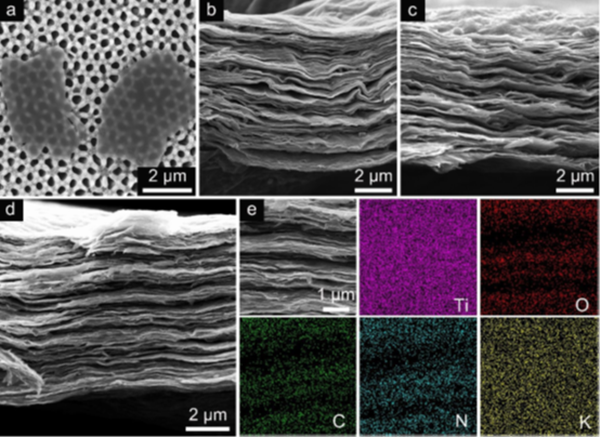J. Mater. Chem. A | Interlayer and surface modified two-dimensional transition metal carbonitride Ti | CNT ₓ for ultrafast supercapacitors
MXenes, as a new two-dimensional nano material, has become a potential electrode material for supercapacitors due to its two-dimensional nano structure and electrochemical active surface. As a member of MXenes, Ti3CNTx is considered to have excellent electrochemical performance. However, like other MXenes, the electrochemical performance of Ti3CNTx is also affected by the agglomeration of nano sheets and surface functional groups. How to effectively expand the layer spacing and modify the surface functional groups, make more electrolyte ions pass through the two-dimensional nano channels as smoothly as possible, and improve the utilization of active sites is the key to improve the electrochemical performance of Ti3CNTx based electrode materials.
The commonly used method is to embed carbon materials, MoS2, polymers and other heterogeneous materials between MXenes layers to inhibit the re stacking of MXenes nano sheets, so as to increase the layer spacing and improve the accessibility of two-dimensional nano channels. In addition, the energy storage performance of MXenes based electrodes can be improved by ion intercalation. Although the capacitance of the electrode can be improved through composite heterogeneous materials and ion intercalation, excessive layer spacing and inserted components will reduce the conductivity of the electrode material, thus affecting the magnification performance. Therefore, when improving the specific capacitance of MXenes electrode, it is necessary to give consideration to its good magnification performance. The electrochemical performance of MXenes depends on the type of surface functional groups. - OH and - F will hinder ion transport, thereby reducing energy storage performance. In addition, annealing treatment can remove most of the - OH groups, thus increasing the accessibility of Ti atoms and promoting more pseudo capacitive reactions. Therefore, increasing the layer spacing and reducing the surface functional group concentration can effectively promote charge transfer and improve the accessibility of two-dimensional nano channels.
Achievement introduction
Recently, Xu Shuaikai, assistant professor of Guangxi University, and Yang Ya, researcher of the Beijing Institute of Nanoenergy and Systems, Chinese Academy of Sciences, obtained 300-K-Ag-Ti3CNTx electrode material with high specific capacitance and high magnification performance through potassium ion intercalation and surface modification of Ti3CNTx based materials, and further introducing silver nanowires between Ti3CNTx layers. The improvement of 300-K-Ag-Ti3CNTx electrochemical performance can be attributed to the increase of Ti3CNTx layer spacing, the decrease of surface functional group concentration and high conductivity. The experimental results show that the mass specific capacitance of Ti3CNTx can be significantly improved by inserting cations between nano sheets and reducing the concentration of functional groups. After the introduction of K+and the removal of functional groups (- OH, - F), the mass specific capacitance can be significantly increased to 464 F g-1. The conductivity of Ti3CNTx based films is affected by interlayer cations and surface functional groups. The conductivity of Ti3CNTx film without any treatment is 885.0 S cm-1. After annealing at 300 ℃, the concentration of surface terminal functional groups decreases, which promotes the conductivity to rise to 1112.8 S cm-1. When K+cations are inserted between Ti3CNTx nano sheets, the conductivity of K-Ti3CNTx decreases to 225.2 S cm-1. After annealing at 300 ℃, the conductivity of 300-K-Ti3CNTx films increases (692.1 S cm-1). In order to improve the conductivity of Ti3CNTx based films, AgNWs were further introduced into 300-K-Ti3CNTx films. The conductivity of the 300-K-Ag-Ti3CNTx film was increased to 1030.93 S cm-1, and showed excellent magnification performance. Even at 2000 mV s-1, its mass specific capacitance could remain at 245 F g-1.
This achievement was published on the top international journal of Materials Chemistry A (influence factor 14.511), entitled: Intercalation and Surface Modification of Two dimensional Transition Metal Carbonitride Ti3CNTx for Ultrafast Supercapacitors.
Picture and text guided reading

Fig. 1. The preparation process of Ti3CNTx based films.

Figure 2. Characterization of Ti3CNTx based films (a) SEM images of a few layers of Ti3CNTx nano sheets obtained. (b - d) are the cross section SEM images of pure Ti3CNTx, 300-Ti3CNTx and 300-K-Ti3CNTx films, respectively. (e) EDS images of Ti, O, C, N and K elements in 300-K-Ti3CNTx films.

Fig. 3. (a) Conductivity of all Ti3CNTx based films. (b) XRD images and (c) FTIR spectra of all Ti3CNTx based films. (d) Cross section SEM image and (e) EDS image of Ti, O, C, N, K and Ag of 300-K-Ag-Ti3CNTx film.

Fig. 4. CV curves of (a) pure Ti3CNTx, (b) 300-K-Ti3CNTx and (c) 300-K-Ag-Ti3CNTx at different scanning rates. (d) Comparison of CV curves of synthesized Ti3CNTx based films. (e) Multiplication properties of all Ti3CNTx based films. (f) Electrochemical impedance spectroscopy of Ti3CNTx based films.
The improvement of electrochemical properties can be attributed to the increase of Ti3CNTx layer spacing, the decrease of surface functional group concentration and the high conductivity. Annealing and cation intercalation will change the structure and layer spacing of Ti3CNTx based films. In this paper, the introduction of K+and the removal of terminal groups (- OH, - F) improved the ion transport process and increased the electrochemical active sites. The mass specific capacitance of Ti3CNTx based films significantly increased to 464 F g-1. In addition, Ag nanowires are introduced between Ti3CNTx nano sheets, which can compensate for the decrease in conductivity caused by K+embedding and annealing. The mass specific capacitance of the prepared 300-K-Ag-Ti3CNTx film can reach 245 F g-1 even at 2000 mV s-1, showing excellent magnification performance. The all solid state symmetric supercapacitors based on 300-K-Ag-Ti3CNTx film show a high energy density of 6.9 mWh g-1 at 350 mW g-1, indicating that they have great potential in the application of flexible energy storage devices. This work will further promote the research of flexible MXene based electrodes; In particular, Ti3CNTx based electrodes have broad application prospects in the field of supercapacitors and wearable electronic devices.

